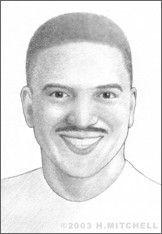James McLurkin
Long Island, New York native James McLurkin loved working with Legos, models, and bicycles as child. But his tinkering went beyond mere child’s play. Soon, he was assembling parts and creating new toys from objects that he found around the house. As a teenager, he was inspired to build his first robot, “Rover,” which he completed during his sophomore year in high school. By the time he finished high school, he had created three robots on his own.
McLurkin was admitted to the Massachusetts Institute of Technology (MIT), where he pursued a degree in electrical engineering. As a student there in 1991, he began working in the university’s Artificial Intelligence Lab, where he first began to develop his idea for “Robot Ants.” These tiny machines (one inch or less per side) each housed internal computers and motors, with sensors that allowed them to detect objects in their paths that they could pick up or avoid. Each robot also had an internal communication system using infrared emitters. These characteristics gave the robots “intelligence.” Theoretically, they would be able to work together to play games and accomplish tasks.
McLurkin, who believes that the greatest inspiration comes from observing nature, studied the behavior of real ants in ant colonies as a basis for his programming. He kept “ant farms” on his desk at school and watched how the creatures worked together. He examined the ways in which the insects structured their workloads so that they could succeed even when some members of the group were no longer able to perform.
McLurkin left MIT after receiving his SB in Electrical Engineering and pursued graduate studies at the University of California, Berkeley. Next, he returned to MIT to pursue his PhD in Computer Science, all while continuing to work on his robot colonies. As part of his doctoral research, McLurkin developed algorithms and techniques for programming “swarms” of autonomous robots to mimic the behavior of bees, including their abilities to cluster, disperse, follow, and orbit.
McLurkin believes that much can be learned by studying the complexities of bee societies, which employ an efficient system of communication that allows the bees to accomplish individual tasks that support the collective goal of the group. McLurkin’s ultimate goal is to construct thousands of swarm robots that have the ability to take on complex tasks in difficult environments, such as searching for land mines, rummaging through earthquake rubble, exploring distant planets, and even identifying and containing chemicals. Serving as a Lead Scientist at iRobot in Somerville, Mass. in 1999, he led a research team in building over 100 small robots (less than five inches long) that could communicate with one another and compute their relative positions. In addition, for a class project in 2002, McLurkin designed the “Swarm Orchestra,” a group of up to 30 robots playing music together, that were spatially organized so that robots with similar instruments are centrally located.
McLurkin co-authored "Tomorrow's Surgery: Micromotors and Microrobots for Minimally Invasive Procedures.” He also spent several years as a consultant for companies such as Walt Disney Imagineering and SensAble Technologies. In 2003, he was awarded the $30,000 Lemelson-MIT Student Prize. TIME magazine included McLurkin in a feature on five leading robotics engineers in 2004; Black Enterprise magazine included him on its “Best and Brightest Under 40” that same year. McLurkin completed his PhD in Computer Science in 2006. McLurkin is now an assistant professor of computer science at Rice University.
In 2009, James McLurkin worked as a professor at Rice University. At Rice University, he was also the Director of the Multi-Robot Systems. During his time at Rice University, James McLurkin created the “Honey Bee Adventure” which was also known as Design Challenge 7. This challenge was made for freshmen engineers to use robots to act like bees and “survive” real bee inspired activities during four different seasons.
As of August 2015, McLurkin still works as an adjunct professor at Rice University, but also became a senior hardware engineer at Google. One of the projects he worked on at Google is project AIY, also known as “Artificial Intelligence and You.” AIY includes do-it-yourself kits and its main goal is to inspire and create more engineers.


